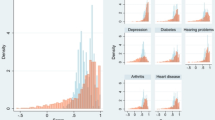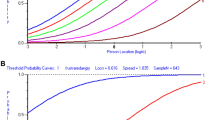Abstract
Purpose
Multi-attribute utility instruments (MAUIs) are widely used to measure utility weights. This study sought to compare utility weights of two popular MAUIs, the EQ-5D-3L and the SF-6D, and inform researchers in the selection of generic MAUI for use with cardiovascular (CVD) patients.
Methods
Data were collected in the Young@Heart study, a randomised controlled trial of a nurse-led multidisciplinary home-based intervention compared to standard usual care. Participants (n = 598) completed the EQ-5D-3L and the SF-12v2, from which the SF-6D can be constructed, at baseline and at 24-month follow-up. This study examined discrimination, responsiveness, correlation and differences across the two instruments.
Results
Both MAUIs were able to discriminate between the NYHA severity classes and recorded similar changes between the two time points although only SF-6D differences were significant. Correlations between the dimensions of the two MAUIs were low. There were significant differences between the two instruments in mild conditions but they were similar in severe conditions. Substantial ceiling and floor effects were observed.
Conclusions
Our findings indicate that the EQ-5D and the SF-6D cover different spaces in health due to their classification systems. Both measures were capable of discriminating between severity groups and responsive to quality of life changes in the follow-up. It is recommended to use the EQ-5D-3L in severe and the SF-6D in mild CVD conditions.





Similar content being viewed by others
References
National Institute for Health and Care Excellence (NICE). (2008). Guide to the methods of technology appraisal. London: NICE.
Euro Qol group. EQ5D: EuroQol; 2011 Retrieved from: http://www.euroqol.org/eq-5d/reference-search/reference-search.html.
Brazier, J., Roberts, J., & Deverill, M. (2002). The estimation of a preference-based measure of health from the SF-36. Journal of Health Economics, 21(2), 271–292.
Feeny, D., Furlong, W., Torrance, G. W., Goldsmith, C. H., Zhu, Z., DePauw, S., et al. (2002). Multiattribute and single-attribute utility functions for the health utilities index mark 3 system. Medical Care, 40(2), 113–128.
AQoL. Assessment of Quality of life 2011 Retrieved from: http://www.aqol.com.au/research-papers.html.
Pharmaceutical Benefits Advisory Committee. Guidelines for preparing submissions to the Pharmaceutical Benefits Advisory Committee 2015 [Appendix 7.2]. Retrieved from: https://pbac.pbs.gov.au/content/information/printable-files/pbacg-book.pdf.
Konerding, U., Moock, J., & Kohlmann, T. (2009). The classification systems of the EQ-5D, the HUI II and the SF-6D: what do they have in common? Quality of Life Research, 18(9), 1249–1261.
McDonough, C. M., & Tosteson, A. N. (2007). Measuring preferences for cost-utility analysis: How choice of method may influence decision-making. Pharmacoeconomics, 25(2), 93–106.
Rabin, R., & de Charro, F. (2001). EQ-5D: A measure of health status from the EuroQol Group. Annals of Medicine, 33(5), 337–343.
Kularatna, S., Whitty, J. A., Johnson, N. W., Jayasinghe, R., & Scuffham, P. A. (2014). Valuing EQ-5D health states for Sri Lanka. Quality of Life Research, 24, 1785–1793.
Dolan, P. (1997). Modeling valuations for EuroQol health states. Medical Care, 35(11), 1095–1108.
Shaw, J., Johnson, J., & Coons, S. (2005). US valuation of the EQ-5D health states: development and testing of the D1 valuation model. Medical Care, 43(3), 203–220.
Ramos-Goñi, J. M., Pinto-Prades, J. L., Oppe, M., Cabasés, J. M., Serrano-Aguilar, P., & Rivero-Arias, O. (2017). Valuation and modeling of EQ-5D-5L health states using a hybrid approach. Medical Care, 55(7), e51–e58.
Brazier, J. E., & Roberts, J. (2004). The estimation of a preference-based measure of health from the SF-12. Medical Care, 42(9), 851–859.
Australian Institute of Health and Welfare. Impact of cardiovascular disease. (2015). Retrieved from: http://www.aihw.gov.au/cardiovascular-health/impact/.
Centers for Disease Control and Prevention Heart Disease. (2015). Retrieved from: http://www.cdc.gov/heartdisease/facts.htm.
European Heart Network. European cardiovascular disease statistics 2012 2015. Retrieved from: http://www.ehnheart.org/cvd-statistics.html.
British Heart Foundation. Heart statistics 2015 Retrieved from: https://www.bhf.org.uk/research/heart-statistics.
Rowen, D., Young, T., Brazier, J., & Gaugris, S. (2012). Comparison of generic, condition-specific, and mapped health state utility values for multiple myeloma cancer. Value in Health, 15(8), 1059–1068.
Lamers, L. M., Bouwmans, C. A., van Straten, A., Donker, M. C., & Hakkaart, L. (2006). Comparison of EQ-5D and SF-6D utilities in mental health patients. Health Economics, 15(11), 1229–1236.
Brazier, J., Roberts, J., Tsuchiya, A., & Busschbach, J. (2004). A comparison of the EQ-5D and SF-6D across seven patient groups. Health Economics, 13(9), 873–884.
Richardson, J., Iezzi, A., & Khan, M. A. (2015). Why do multi-attribute utility instruments produce different utilities: The relative importance of the descriptive systems, scale and ‘micro-utility’ effects. Quality of Life Research, 24(8), 2045–2053.
Feeny, D., Spritzer, K., Hays, R. D., Liu, H., Ganiats, T. G., Kaplan, R. M., et al. (2012). Agreement about identifying patients who change over time: cautionary results in cataract and heart failure patients. Medical Decision Making: An International Journal of the Society for Medical Decision Making, 32(2), 273–286.
van Stel, H. F., & Buskens, E. (2006). Comparison of the SF-6D and the EQ-5D in patients with coronary heart disease. Health and Quality of Life Outcomes, 4, 20.
Chan, Y.-K., Stewart, S., Calderone, A., Scuffham, P., Goldstein, S., & Carrington, M. J. (2012). Exploring the potential to remain “Young @ Heart”: Initial findings of a multi-centre, randomised study of nurse-led, home-based intervention in a hybrid health care system. International Journal of Cardiology, 154(1), 52–58.
Carrington, M. J., Chan, Y. K., Calderone, A., Scuffham, P. A., Esterman, A., Goldstein, S., et al. (2013). A multicenter, randomized trial of a nurse-led, home-based intervention for optimal secondary cardiac prevention suggests some benefits for men but not for women: the Young at Heart study. Circulation: Cardiovascular Quality of Outcomes, 6(4), 379–389.
Williams, J. R. (2008). The Declaration of Helsinki and public health. Bulletin of the World Health Organization, 86(8), 650–652.
Antes, G. (2010). The new CONSORT statement. BMJ: British Medical Journal, 340(7748), 666–667.
Ramos-Goñi, J. M., & Rivero-Arias, O. (2011). eq5d: A command to calculate index values for the EQ-5D quality-of-life instrument. Stata Journal, 11(1), 120–125.
Cohen, J. (1992). A power primer. Psychological Bulletin, 112(1), 155–159.
Kularatna, S., Whitty, J. A., Johnson, N. W., Jayasinghe, R., & Scuffham, P. A. (2016). A comparison of health state utility values associated with oral potentially malignant disorders and oral cancer in Sri Lanka assessed using the EQ-5D-3 L and the EORTC-8D. Health Quality of Life Outcomes, 14, 101.
Teckle, P., Peacock, S., McTaggart-Cowan, H., van der Hoek, K., Chia, S., Melosky, B., et al. (2011). The ability of cancer-specific and generic preference-based instruments to discriminate across clinical and self-reported measures of cancer severities. Health Quality of Life Outcomes, 9, 106.
Whitehurst, D. G. T., Bryan, S., & Lewis, M. (2011). Systematic review and empirical comparison of contemporaneous EQ-5D and SF-6D group mean scores. Medical Decision Making, 31(6), E34–E44.
Pickard, A. S., Johnson, J. A., & Feeny, D. H. (2005). Responsiveness of generic health-related quality of life measures in stroke. Quality of Life Research, 14(1), 207–219.
Longworth, L., & Bryan, S. (2003). An empirical comparison of EQ-5D and SF-6D in liver transplant patients. Health Economics, 12(12), 1061–1067.
Brazier, J., Rowen, D., Tsuchiya, A., Yang, Y., & Young, T. A. (2011). The impact of adding an extra dimension to a preference-based measure. Social Science and Medicine, 73(2), 245–253.
National Institute for Health and Care Excellence (NICE). (2001). Technical guidance for manufacturers and sponsors on making a submission to a technology appraisal. London: NICE.
Author information
Authors and Affiliations
Corresponding author
Ethics declarations
Conflict of interest
All authors declare that they have no conflict of interest.
Ethical approval
This study made use of clinical trial data. The trial was registered with the Australian New Zealand Clinical Trials Registry (No. 12608000014358) and conforms to both the principles outlined in the Declaration of Helsinki.
Informed consent
The study was approved by the human Research Ethics Committee of Uniting Care Health, Brisbane, Australia, and all patients provided written informed consent to participate.
Rights and permissions
About this article
Cite this article
Kularatna, S., Byrnes, J., Chan, Y.K. et al. Comparison of the EQ-5D-3L and the SF-6D (SF-12) contemporaneous utility scores in patients with cardiovascular disease. Qual Life Res 26, 3399–3408 (2017). https://doi.org/10.1007/s11136-017-1666-6
Accepted:
Published:
Issue Date:
DOI: https://doi.org/10.1007/s11136-017-1666-6




